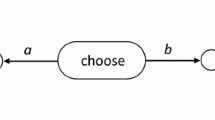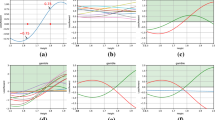Abstract
Interactivity generates paradox in that the interactive control by one systemC of predicates about another system-under-studyS may falsify these predicates. We formulate an “interactive logic” to resolve this paradox of interactivity. Our construction generalizes one, the Galois connection, used by Von Neumann for the similar quantum paradox. We apply the construction to atransition system, a concept that includes general systems, automata, and quantum systems. In some (classical) automataS, the interactive predicates aboutS show quantumlike complementarity arising from interactivity: The interactive paradox generates the quantum paradox. Some classicalS's have noncommutative algebras of interactively observable coordinates similar to the Heisenberg algebra of a quantum system. SuchS's are “hidden variable” models of quantum theory not covered by the hidden variable studies of Von Neumann, Bohm, Bell, or Kochen and Specker. It is conceivable that some quantum effects in Nature arise from interactivity.
Similar content being viewed by others
References
Artin, E. (1957).Geometric Algebra, Interscience, New York.
Bell, J. S. (1964). On the Einstein-Podolsky-Rosen paradox,Physics (U.S.A.),3, 195.
Bell, J. S. (1966). On the problem of hidden variables in quantum mechanics,Rev. Mod. Phys.,38, 447.
Birkhoff, G. (1948).Lattice Theory, Amer. Math. Soc. Colloquium Publications, Vol. 25, rev. ed., New York.
Birkhoff, G., and Von Neumann, J. (1936). The logic of quantum mechanics,Ann. Math.,37, 823.
Bohm, D. (1952). A suggested interpretation of the quantum theory in terms of “hidden” variables I, Ii,Phys. Rev.,85, 166, 180.
Brown, G. S. (1969).Laws of Form, Allen and Unwin, London.
Chaitin, G. (1966). On the length of programs for computing finite binary sequences,J. Assoc. Computing Machinery,13, 547, 16, 145.
Chaitin, G. (1982). Algorithmic Information Theory 1982,Encycl. of Statistical Sciences 1, Wiley, New York, p. 38.
Conway, J. H. (1971).Regular algebra and finite machines, Chapman and Hall, London.
Finkelstein, D. (1963). The logic of quantum physics,Trans. N.Y. Acad. Sci.,25, 621–663.
Finkelstein, D. (1982). Quantum sets and Clifford algebras,Int. J. Theor. Phys.,21, 489.
Finkelstein, D. (1966). Matter, space, and logic,Boston Colloquium on the Philosophy of Science, Vol. 5.
Holland, Jr., S. S., (1970). The current interest in orthomodular lattices, inTrends in Lattice Theory, ed. Abbott, J. C., Van Nostrand Reinhold, New York. Reprinted inThe Logico-Algebraic Approach to Quantum Mechanics, Vol. I, ed. Hooker, C. A., Reidel, Dordrecht (1975).
Hopcroft, J. E. and Ullman, J. D. (1979).Introduction to Automata Theory, Languages and Computation. Addison-Wesley, Reading, Mass.
Kochen, S., and Specker, E. P. (1967). The problem of hidden variables in quantum mechanics,J. Math. Mech.,17, 59–87.
Kaufman, L., private communication.
Moore, E. F. (1956). Gedanken experiments on sequential machines, inAutomata Studies, ed. Shannon, C. E., and McCarthy, J., Princeton University Press, Princeton, New Jersey.
Vareia, F. J., private communication.
Von Neumann, J. (1960).Continuous geometry, Princeton University Press, Princeton, New Jersey.
Von Neumann, J. (1954). Unsolved problems in mathematics, Address to International Mathematical Congress, Amsterdam, September 2, 1954, unpublished. Manuscript, Von Neumann archives, Library of Congress, Washington, D.C.
Von Neumann, J. (1932).Mathematische grundlagen der quantenmechanik, Springer Verlag, Berlin. Reprinted, Dover, New York (1943).
Wheeler, J. A. (1982). The computer and the universe,Int. J. Theor. Phys.,21, 557.
M. Zwick, (1978). Quantum measurement and Gödel's proof,Speculations Sci. Technol.,1, 135.
Author information
Authors and Affiliations
Rights and permissions
About this article
Cite this article
Finkelstein, D., Finkelstein, S.R. Computational complementarity. Int J Theor Phys 22, 753–779 (1983). https://doi.org/10.1007/BF02085960
Received:
Issue Date:
DOI: https://doi.org/10.1007/BF02085960




